|
GETAC B360
Full ruggedness and state-of-the-art performance in a machine no larger or heavier than the semi-rugged competition.
By Conrad H. Blickenstorfer, photography by Carol Cotton)
Share on:



On June 3, 2020, Getac introduced the B360, a fully rugged 13.3-inch laptop designed, according to the company, to set a powerful new benchmark for innovation in the rugged computing industry. Fully engineered for 5G, the B360 claims best-in-class computing speed, brightness, and rugged reliability, resulting in a highly advanced mobile solution that excels in even the most challenging working conditions. The B360 further shines with a powerful 10th generation Intel Core processor lineup of available CPUs.

So where does the new Getac B360 fit into the rugged laptop landscape? Given its "B360" designation, you'd think it might be a direct replacement for the Getac B300, but it's not. That old warhorse was designed specifically to take on the original Toughbook, heavy build and square-ish 4:3 screen aspect ratio and all. That rivalry, however, came to an end, each venerable platform having yielded to lighter and more modern designs.
 Is the new B360 then taking on the new guard of lighter, thinner more modern laptops, like the Panasonic Toughbook 55, the Dell Latitude 5420 Rugged or the Durabook S14I? Is the new B360 then taking on the new guard of lighter, thinner more modern laptops, like the Panasonic Toughbook 55, the Dell Latitude 5420 Rugged or the Durabook S14I?
That's much closer, with each of those machines pretty much the same size and weight as the new B360. But it'd still be comparing apples and oranges because those machines are all semi-ruggeds with only moderate ingress protection and drop specs. Whereas the new Getac B360 is a fully rugged machine with IP66 sealing and a most impressive 6-foot drop spec.
What does that mean? In essence that Getac baked full and not just "semi" ruggedness into the B360 even though it has the footprint, thin profile and low weight of a semi-rugged. That is quite remarkable.
But Getac didn't stop even there. It also leapfrogged the competition by equipping the B360 with the very latest Intel 10th generation processors and the tech that goes with it, by far the brightest screen, that superfast PCIe NVMe solid state disk technology, and more. A new benchmark for sure.
The picture above shows how sleek and slender the new Getac B360 is. It starts at only around five pounds, just where the semi-rugged competition is (weight depends much on configuration and options in this class). In order to make that possible, Getac had to compromise somewhere: the two (hot-swappable) slender power packs add up to just 46.6 watt-hours. Given the very bright screen, that's not very much, even with the new Intel chips' excellent power management.
So what do you get with the Getac B360?
What you get with the Getac B360 is a rugged laptop computer, and by "rugged" we don't mean just a tough look and slightly sturdier materials. This is a tool for the job designed and built by one of the very pioneers in rugged laptops. Depending on how one looks at it, the B360 will have great appeal for those who have considered rugged laptops in the past but always found them to be too bulky and too heavy, and it can also be very interesting for those who like the lighter weight and lesser bulk of semi-ruggeds but not their marginal ruggedness and protection. There's the price of course, and while we don't know Getac's final pricing yet, we assume it's at the rugged and not at the semi-rugged level. That would make the new B360 primarily a successor of the older and much heavier B300, and competitor to the fully rugged laptops from the competition at Panasonic, Dell, Durabook and a few others.
What general size class is B360? Its 13.3-inch display is right where rugged laptop screens have been for many years, though it is now wide-format instead of the traditional squarish 4:3, and the B360 has higher resolution. Its footprint of 13.5 x 11.1 inches is fairly substantial. Despite its ruggedness and sturdy build, it's just 1.4 inches thick and weighs, for a fully rugged laptop, an amazingly low 5.1 pounds. The table below shows where the new B360 fits into Getac's comprehensive roster of semi-rugged and fully rugged laptops:
|
Getac Rugged Windows Notebooks: Where the B360 fits in
|
|
Model
|
V110
|
B300
|
B360
|
S410
|
X500
|
|
|

|

|

|

|

|
|
Display size
|
11.6-inch
|
13.3-inch
|
13.3-inch
|
14.0-inch
|
15.6-inch
|
|
Ruggedness
|
Fully rugged
|
Fully rugged
|
Fully rugged
|
Semi rugged
|
Fully rugged
|
|
Resolution
|
1920 x 1080
|
1024 x 768
|
1920 x 1080
|
1366 x 768 or 1920 x 1080 1200
|
1920 x 1080
|
|
Pixels/inch
|
190 ppi
|
96 ppi
|
166 ppi
|
112 or 157 ppi
|
141 ppi
|
|
Aspect ratio
|
16 : 9
|
4 : 3
|
16 : 9
|
16 : 9
|
16 : 9
|
|
Luminance
|
800 nits
|
700/1400 nits
|
1400 nits
|
800/1000 nits
|
1000 nits
|
|
Size (inches)
|
12.3 x 9.4 x 1.5
|
11.9 x 10.4 x 2.4
|
13.5 x 11.1 x 1.4
|
13.8 x 11.5 x 1.4
|
16.1 x 12.6 x 2.5
|
|
Volume (cu-in)
|
173.4
|
297.0
|
209.8
|
222.2
|
507.2
|
|
Weight (lbs.)
|
4.4
|
7.7
|
5.1
|
4.9
|
11.4
|
|
CPUs
|
8th gen Core
|
8th gen Core
|
10th gen Core
|
8th gen Core
|
7th gen Core
|
|
CPU Code
|
Whiskey Lake
|
Kaby Lake Refresh
|
Comet Lake
|
Whiskey Lake
|
Kaby Lake
|
|
Max RAM
|
32GB
|
32GB
|
64GB
|
64GB
|
64GB
|
|
Max primary storage
|
1TB SATA SSD
|
1TB SATA SSD or HDD
|
1TB PCIe NVMe SSD
|
1TB SATA SSD
|
1TB SATA SSD or HDD
|
|
Std. Battery
|
46.6 whr
|
94.0 whr
|
46.6 whr
|
46.6 whr
|
94.0 whr
|
|
Operating temp
|
-6° to 140° F
|
-20° to 140° F
|
-20° to 145° F
|
-20° to 145° F
|
-4° to 131° F
|
|
IP rating
|
IP65
|
IP65
|
IP66
|
IP53
|
IP65
|
The B360 comes with up to 64GB of fast DDR4 RAM and up to 1 terabyte of PCIe NVMe solid state disk for primary storage. Optional secondary storage is up to another 1 terabyte of SATA solid state disk (the different interface precludes RAID configuration).
The B360 display (which is of the IPS variety, as all recent Getacs) measures 13.3 inches diagonally and offers 1920 x 1080 pixel resolution, making for a crisp 166 pixels per inch, and 16:9 aspect ratio. Its 1400 nits luminance is extremely bright, brighter than almost anything else out there. There's, of course, 10-point capacitive multi-touch and a hard tip stylus.
Due to weight and space issues, battery capacity is always a tricky thing with laptops. To arrive at the much slimmer profile and considerably lower weight compared to traditional rugged laptops, Getac had to do without the kind of massive power pack found in older rugged machines. Instead, the B360 comes with two smaller and very thin (just 3/8th of an inch) hot-swappable 23.31 watt-hour batteries.
Despite its remarkably light weight, the Getac B360 feels tough and substantial. It's an elegant, purposeful design where form follows function. Most rugged laptops use a black/dark silver color scheme with fine powder coating, and the B360 is no exception. Surfaces are attractively contoured. Much of the housing is metallic. A sturdy carry handle is part of the design. Below is a look at the B360 from the top and from all four sides:
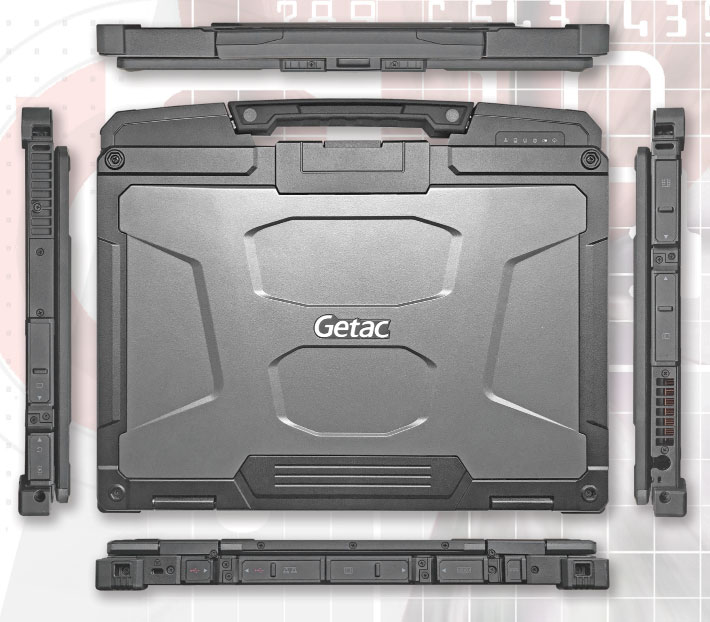
Unlike phones and consumer tablets, rugged laptops have a full complement of standard-size ports. Sealing and protection of those ports is an important design consideration, one that is nowhere near as easy to implement as it sounds. Getac's solution for the B360 are elaborate hinged plastic doors with rubber seals. The doors must be pushed into place, which can require quite a bit of force. Once in place they are snap-clicked into a locked position. You have to be careful to get them sealed properly and snapped into place the proper way, but once you get the hang of it, it's a good, reliable solution.
Below is a look at the backside of the B360, with all of its protective doors removed (each is secured with two small Philips screws). From left to right, there's a Kensington lock slot, two USB 3.1 gen 2 ports, an RJ45 connector, an HDMI port, two areas for optional and configurable I/O (our unit came with a VGA port and a DB9 legacy serial port), and finally the power jack.

Below are the two side views of the B360, again with all protective doors removed. On top is the left side view with, from left to right, the tether anchor hole for the stylus, the stylus garage, the fan/heat exchanger grille, primary and secondary mass storage, and smart card reader.
On the bottom is the right sideview. Here we see, from left to right, the area for an optional barcode scanner (which our tester didn't have), SIM and SD card reader slots, power, 3.5mm audio jack, and a PowerShare USB 2.0 port.

 Note that Getac offers a good number of customization options. The I/O area in the back, for example, can be equipped with various I/O combos, such as VGA/RS232, DiaplayPort/RS232 or USB-C/RS232. Likewise, the laptop can be equipped with optional fingerprint scanner or an HF RFID reader. Note that Getac offers a good number of customization options. The I/O area in the back, for example, can be equipped with various I/O combos, such as VGA/RS232, DiaplayPort/RS232 or USB-C/RS232. Likewise, the laptop can be equipped with optional fingerprint scanner or an HF RFID reader.
The bottom side of the B360 is mostly unadorned. The two batteries fit flush into the body of the laptop. A fairly elaborate springloaded lockable mechanism keeps the them securely in place, but also makes them replaceable within seconds. Unlike other Getac tablets and laptops, the B360 doesn't have extended life options (the also available B360 Pro does).
In the center of the bottom is the surface-mount docking connector for the B360's optional office and vehicles docks. Next to that appear to be antenna pass-throughs.
Note here that Getac chose a different customization path with the B360 laptop than, for example, their UX10 rugged tablet. The UX10 tablet has three different expansion areas that each can accommodate one of the several available options, which makes for a very large number of possible permutations. With the B360, Getac gave the device a good number of expected I/O and a lesser number of optional configurations.
Exemplary design
It's probably not easy to be a designer of computers. A smartphone is a small rectangle with a screen and really nothing else. A tablet is a larger rectangle with a screen and not much else. And a laptop is a box with keyboard in it and a hinged screen that's like the cover of the box. Form follows function to the extreme. But even most functions don't need to follow form in a computer; they are all electronic.
So to come up with an elegant, good-looking laptop that conveys toughness, competence, professionalism, and a unique brand identity, that's not easy. Yet, with the B360 Getac clearly has done just that. Colors, materials, textures, lines, corners, labels, everything looks, works, and fits just right. Every part is designed to fill a purpose.
The attention to detail on this laptop is more than impressive. Yes, form follows function, but form also contributes to ergonomics, ease-of-use, and also eye-pleasing visual design. Just like the Getac UX10 rugged tablet we reviewed a few months ago, the Getac B360 convinces on all levels. They may be just a tablet and a laptop, but they are both anything but generic.
And then there are the details. German philosopher Friedrich Nietzsche once observed that that's where the devil is, in the details. Details — all the small little things that often get overlooked, and that, if not properly designed and attended to, will come back to haunt you.
A laptop has lots of details, and Getac quite obviously thought them through. Below are some of the details that showcase this impressive attention to every detail:
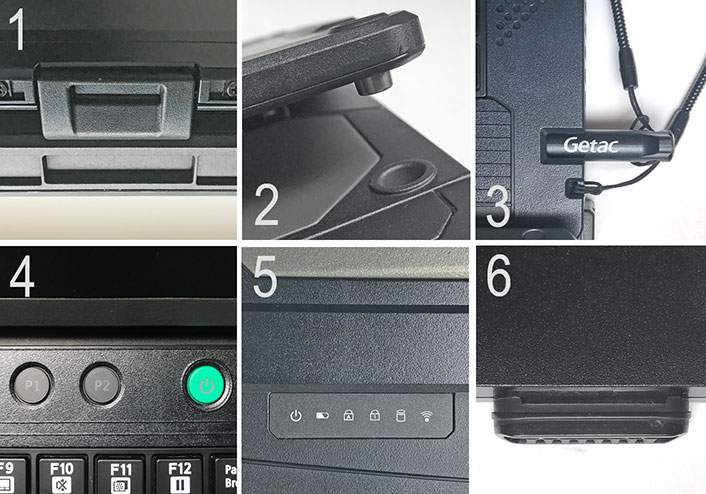
Clockwise and starting from the upper left, you can see:
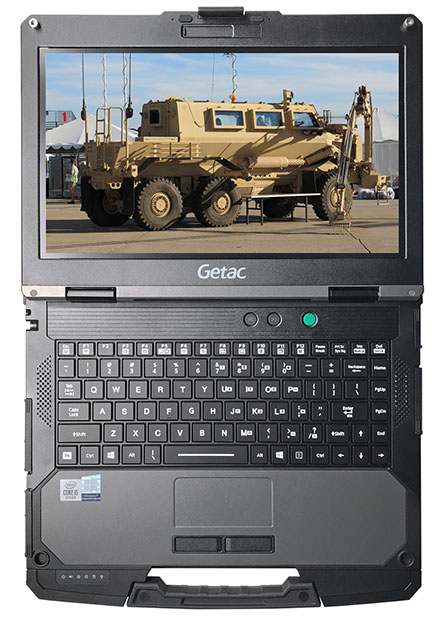 - The clasp that secures the LCD screen against the computer case with the keyboard is one of the most important parts of every laptop. You don't want for the screen to open up when it shouldn't, and you don't want a clasp/lock that's clumsy and hard to operate. Getac got it just right with a spring-loaded clasp that automatically locks, but also easily lets go with just a tap on the clasp.
- If a rugged computer gets dropped (and it will), the screen must not be jarred open upon impact. Two steel bolts make sure that would never happen in the B360.
- If you use a stylus with your laptop, it should be tethered and it should have a stylus garage in a convenient and easily located spot. The B360 has that. And it says "Getac" on it. Most of us have many styli. To know which one goes with which device is a very good idea.
- Too many buttons are confusing, especially if they are poorly labeled. Getac gave the B360 just three, a good number. They are backlit and clearly labeled. A green power button and two programmable function buttons. Excellent.
- Annunciator lights tell the user what the computer is doing. All too often such lights are poorly labeled and in hard-to-see places. On the B360 they are clearly labeled and where you can easily see them, as it should be.
- The Getac B360's hot-swappable batteries are flush-mounted into the bottom of the computer case. It'd require a big seal to keep the entire battery compartment dry. So Getac used just an O-ring seal around the battery connector. A common solution, but especially well implemented here.
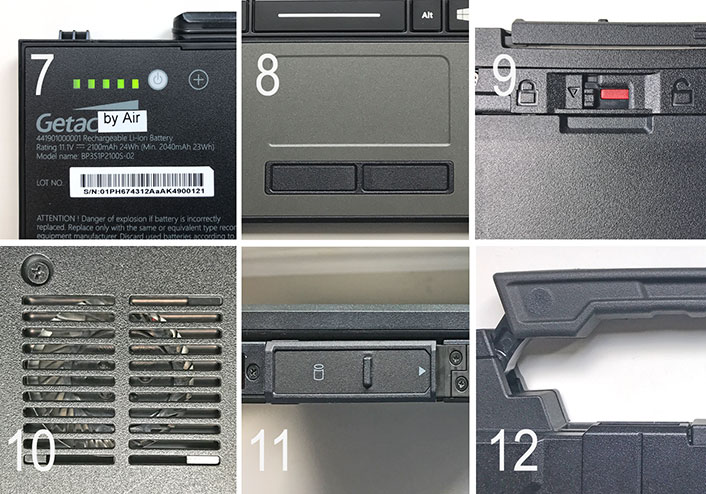
And another set of nice details: clockwise and starting from the upper left, you can see:
 - It's great to have hot-swappable batteries, but do you always know if your spares are actually charged? And how much? With the B360's batteries there's never any doubt; just push a button and five LEDs show the charge level.
- Many touch pads are too deeply recessed for convenient use. The B360's 3-1/4 x 1-5/8 inch capacitive multi-touch pad is recessed only as much so you can easily sense its perimeter with your finger(s). It's also very responsive and has the exact right surface stiction.
- You want to be able to replace hot-swappable batteries quickly and easily, but you don't want to have them come loose or fall out by mistake. The B360 has lockable spring-loaded levers that work just right.
- The B360 has a small fan and a fan grille. Have no fear, though: the fan's housing is completely sealed to the interior of the laptop, and the fan itself works even underwater.
- This is the port sealing method Getac uses on the B360. Sealing external standard ports is never easy, designing such ports isn't easy, and making sure they are properly secured requires a conscious effort. It takes a bit of getting used to the ports on the B360, but they get the job done.
- Hard carry handles are almost a must on a rugged laptop, but many are bulky and not all are convenient to use. We like the B360's design where the handle is nicely integrated but then clicks into a carrying position when you need it.
Per Getac's request we did not dismantle the B360 to get an idea what it looks like inside, how easy or difficult it is to disassemble and reassemble the unit, and get an idea of the type of thermal management system. We did, however, use our FLIR One IR thermal imaging camera to see heat flows and heat dissipation. The images below show along the top of the keyboard what we assume is copper heat piping to conduct processor and other heat to the heat exchanger/fan assembly. Even while running performance benchmarks, exhaust air consistently stayed in the low 80F range.
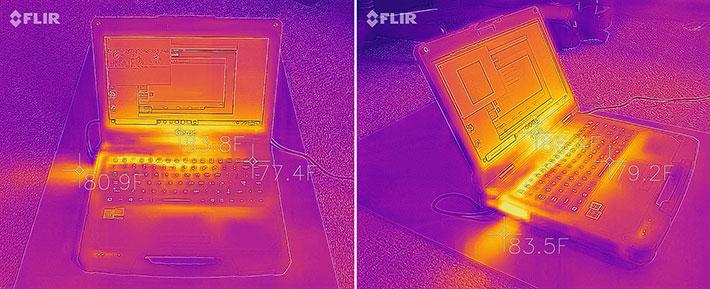
Keyboard and hardware controls
A good keyboard is very important in a notebook for the field. If it isn't good, one might as well use a tablet. Getac has used a variety of keyboard technologies in its rugged and semi-rugged notebooks over the years. Initially Getac laptops used older-style beveled keys. Over time, keyboards became more water-resistant and used mechanical membrane technology. The new B360 likewise uses an LED backlit membrane keyboard, with an optional LED backlit rubber keyboard also available.
In terms of layout and look, these days almost everyone uses the "island-style" look with fairly short key travel but good tactile feedback. That's important in the field; everything must be optimized for functionality, clarity and ease of use. The thick type and white-on-black icons make the B360 keyboard look a bit busy and cluttered. Function labels are icon-style black on white, sometimes below and sometimes to the right of the default character of the key. The whole design looks and feels much like the standard Apple keyboard, which today is as much praised for its "look and feel" as the original IBM PC keyboard was at the dawn of personal computing.
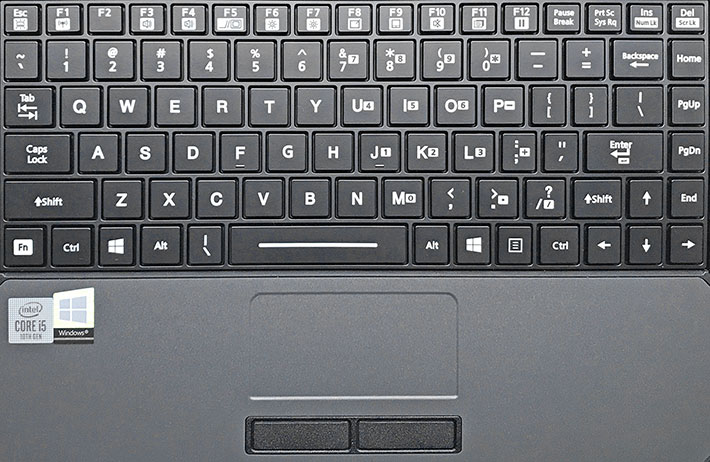
Placement of the keyboard in relation to the slightly recessed capacitive multi-touch touchpad and the two "mouse" buttons is just right. And, almost needless to say for full-size laptop, the all-important QWERTY layout is 100%-scale. That means the distance between the center of the letter Q and the center of the letter P is exactly 6-3/4 inches. 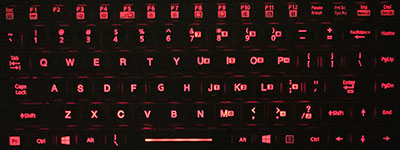 This way, anyone used to a standard keyboard will have no problem finding the key and feeling at home, even if they are not full touch typists. This way, anyone used to a standard keyboard will have no problem finding the key and feeling at home, even if they are not full touch typists.
The LED-based backlight can be activated and toggled through three brightness settings via a function key combination. Illumination is reddish-tinted white, and it clearly illuminates the keys in semi and full darkness.
Unlike some earlier Getac rugged laptops we reviewed, illumination doesn't bleed out much around the keys in the dark. That makes the layout easier to read in the dark.
Powerful Intel 10th generation "Comet Lake" Core processor technology
Deciding on the right processor is one of the most difficult tasks a mobile system designer faces. Customers want maximum performance and great battery life but, up to recently, you could only get either one or the another. That's been changing as each successive generation of Intel's high-end processors has become more and more power-efficient.
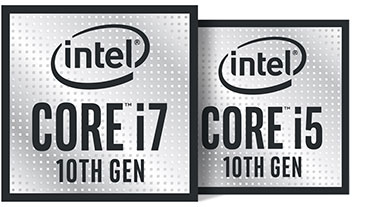
A good part of the Getac B360's appeal comes from its designers' ability to put so much advanced computing power into a package that's not only rugged, but also remarkably light and compact. That's made possible by a selection of Intel's 10th generation of Core processors, the first ever to offer not just quad-core configurations in ultra-low voltage mobile CPUs, but even a few chips with six cores and 12 threads.
Truth be told, it's no longer easy to differentiate between Intel processor generations. Just a few years ago, all one had to know in order to get an idea of the performance and capabilities of a processor was to know its codename. There were substantial differences between a "Sandy Bridge," "Haswell," or "Skylake" chip, with rapidly shrinking miniaturization making for ever more power and efficiency.
That ongoing miniaturization, which enabled Intel to put more and more transistors onto a chip, has slowed down quite a bit, with most of the progress now coming from optimization between, and sometimes within, generations. As a result, the 10th generation of Core processors is anything but homogenous. Code names such as "Amber Lake," "Ice Lake," and "Comet Lake" are all being used for "10th generation" Core processors.
While each of those code names and recent generations added and improved features and capabilities, the biggest thing is doubtlessly the move from dual-core to quad-core designs that happened in the 8th generation, and now the addition of hexa-core designs. Four cores can do more than two cores, and six more than four, and this allowed Intel to lower the base clock speeds of these chips, cutting down power consumption and heat generation. The ongoing refinements, on the other hand, allowed raising maximum "turbo" clock speeds higher. The overall result is higher peak performance with an overall power draw that's no more (and sometimes less) than it was with less powerful dual-core processors.
|
Available B360 CPUs
|
Intel Core i7
|
Intel Core i7
|
Intel Core i5
|
|
Model
|
10710U
|
10510U
|
10210U
|
|
Cores/Threads
|
6/12
|
4/8
|
4/8
|
|
Base Clock Speed
|
1.10 GHz
|
1.80 GHz
|
1.60 GHz
|
|
Turbo Speed
|
4.70 GHz
|
4.90 GHz
|
4.20 GHz
|
|
Thermal Design Power (TDP)
|
15 watts
|
15 watts
|
15 watts
|
|
Smart Cache
|
12MB
|
8MB
|
6MB
|
|
Integrated graphics
|
UHD Graphics
|
UHD Graphics
|
UHD Graphics
|
|
Graphics base speed
|
300 MHz
|
300 MHz
|
300 MHz
|
|
Graphics max speed
|
1.15 GHz
|
1.15 GHz
|
1.10 GHz
|
|
Relative CPU cost
|
1.49
|
1.38
|
1.00
|
|
Intel Thermal Velocity Boost
|
No
|
Yes
|
Yes
|
Now let's look at the new tech. Here, Getac treats B360 customers to state-of-the-art "Comet Lake" Intel 10th generation i5 and i7 Core processors. Led by an i7-10710U hexa-core chip with 12 threads and two quad-core options, there is plenty of performance.
These new marvels are amazingly power-efficient, too. They can idle along at very low clock frequencies, but quickly ramp up to blistering turbo speed to do the heavy lifting. The table to the left shows the basics of the three chips Getac B360 customers can select from (see full table here).
Over the past several Core processor generations, Intel has managed to provide greater and greater performance without paying the price in increasing power draws. In the past, rugged laptops like the B360 used processors with thermal design powers of 35 and sometimes even 45 watts. That meant dismal battery life. Today, we see far greater performance from chips with thermal design powers of just 15 watts. But that's just one side of the improvement. By first switching to two cores, then four, and now six, Intel could greatly decrease the default clock frequencies of processors. Doing routine tasks, these chips just idle along, not using much power at all. But if performance is needed, these new processors have very high "turbo" speeds, in the case of the top processor available for the B360, the Core i7-10710U, an increase of almost 400%!
An important decision systems designers must make is whether to use passive cooling or an active system fan. In the past, Getac used advanced passive cooling systems even in powerful standard voltage systems. The rationale was the elimination of fan noise and potential mechanical failure. Well, the B360 platform does have that small fan. But unlike some fans that are annoyingly loud and on almost all the time, this one is unobtrusive and doesn't come on often, but it IS a fan, and sometimes you can definitely hear it. Getac likely gave that much thought and concluded that an active fan still offers better protection against overheating and, more importantly, makes it possible for the CPU to operate without significant performance drops even at the upper end of its operating temperature range.
In order to get a sense of where the Getac B360's performance level stands compared to some other leading rugged and semi-rugged laptops with different types of processors and configurations, we installed Passmark Software's PerformanceTests 6.1 and 9.0 that run several dozen tests covering CPU, 2D graphics, 3D graphics, memory, and disk and then compute scores for each category and an overall PassMark score.
The results are as follows:
|
Rugged and Semi-rugged Rugged Laptop Benchmark Overview
|
|
PERFORMANCE COMPARISON
|
Getac
|
Dell
|
Durabook
|
Panasonic
|
|
Model
|
B360
|
Latitude 5420
|
DURABOOK S14I
|
TOUGHBOOK 55
|
|
Year tested
|
2020
|
2019
|
2019
|
2019
|
|
Processor Type
|
Intel Core
|
Intel Core
|
Intel Core
|
Intel Core
|
|
Processor Type: Intel
|
i5-10210U (G10)
|
i7-8650U (G8)
|
i5-8250U (G8)
|
i5-8365 (G8)
|
|
Code name
|
Comet Lake
|
Kaby Lake R
|
Kaby Lake R
|
Whiskey Lake
|
|
Thermal Design Power (TDP)
|
15 watts
|
15 watts
|
15 watts
|
15 watts
|
|
CPU Clock
|
1.60GHz
|
1.90GHz
|
1.60GHz
|
1.60GHz
|
|
CPU Turbo
|
4.20GHz
|
4.20GHz
|
3.40GHz
|
4.10GHz
|
|
CPU Cores/Threads
|
4/8
|
4/8
|
4/8
|
4/8
|
|
Graphics
|
Intel UHD Graphics
|
Intel UHD Graphics 620
|
Intel HD Graphics 620
|
Intel UHD Graphics 620
|
|
Minimum Power Draw
|
2.0 watts
|
3.2 watts
|
NA
|
2.5 watts
|
|
PassMark CPU Mark 6.1
|
9,094.8
|
10,460.3
|
6,850.6
|
11,110.8
|
|
2D Graphics Mark 6.1
|
459.7
|
330.7
|
305.4
|
409.6
|
|
Memory Mark 6.1
|
1,859.9
|
2,653.8
|
1,843.3
|
1,973.9
|
|
Disk Mark 6.1
|
15,505.4
|
9,443.5
|
4,951.9
|
4,757.3
|
|
3D Graphics Mark 6.1
|
595.6
|
786.4
|
425.5
|
503.2
|
|
Overall PassMark 6.1
|
6,027.3
|
5,331.3
|
3,265.7
|
4,424.4
|
|
PassMark CPU Mark 9.0
|
8,555.3
|
9,178.2
|
6,839.9
|
8,959.2
|
|
2D Graphics Mark 9.0
|
701.3
|
726.0
|
498.7
|
686.7
|
|
Memory Mark 9.0
|
2,285.3
|
2,855.8
|
2,240.7
|
2,095.4
|
|
Disk Mark 9.0
|
22,388.8
|
11,023.5
|
4,736.3
|
5,214.8
|
|
3D Graphics Mark 9.0
|
1,105.2
|
1,245.1
|
872.7
|
1,049.5
|
|
Overall PassMark 9.0
|
3,629.8
|
3,906.9
|
2,726.5
|
3,325.6
|
What do the benchmarks show? Some of the results are obvious and expected, others less so.
First, when perusing any benchmark results, do keep in mind that most of these high end products are available with different processor options. We can only report the results of the test machines we were sent for review. Other processor options may yield different results.
Even though our test unit was equipped with the least powerful of the available processor options (the Core i5-10210U), the Getac B360 turned out to be a blistering performer. To illustrate the stunning advances in mobile computing technology over the past few years, the 2020 Getac B360 is more than eleven times faster overall than a fully rugged, top-of-the-line Getac B300X notebook with one of the very first Core processors we benchmarked in 2010 ago.
The competing laptops we're showing in the table are all cream of the crop machines, high-quality, well engineered modern rugged laptops. Each offers various performance options, and even at this lofty level, there is a good degree of performance parity. However, there can still be strategic advantage. And one such advantage the Getac B360 has is its crushing storage performance. The sub-test weighting differs from benchmark to benchmark, but Getac's decision to use very high performance PCIe NVMe solid state disk (as compared to older, slower SATA-based solid state storage) very clearly pays off.
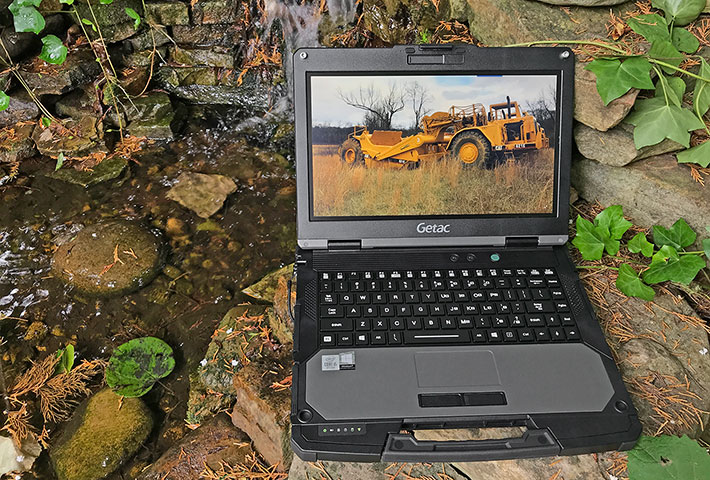
Battery life — excellent power conservation
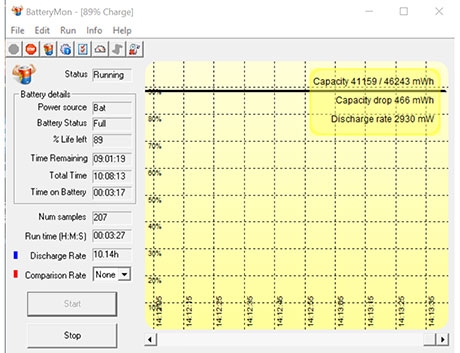 Just as is the case in electric cars, balancing range with battery size, weight and cost is a never-ending challenge for designers of rugged computing gear. Back when rugged laptops were heavy and bulky, there was room for a big battery, and customers didn't mind the weight so much. But that has changed. The Getac B360 is a full inch thinner than the old Getac B300, and at least 2.5 pound lighter as well. How does that affect battery size and power in the B360? Just as is the case in electric cars, balancing range with battery size, weight and cost is a never-ending challenge for designers of rugged computing gear. Back when rugged laptops were heavy and bulky, there was room for a big battery, and customers didn't mind the weight so much. But that has changed. The Getac B360 is a full inch thinner than the old Getac B300, and at least 2.5 pound lighter as well. How does that affect battery size and power in the B360?
Battery technology has come a long way, but progress remains slower than overall progress in electronics and miniaturization. Does that mean today's slender power packs have less capacity? Often they do. Rugged devices of the past routinely had standard batteries with 90 or 100 watt-hour capacities. Today it's often just half of that. Combined, the B360's two slender (just 3/8-inch thick) batteries, for example, only pack 46.6 watt-hours, a far cry from the old B300's single 94 watt-hour power pack that all by itself weighed more than an iPad Air 2.
Getac specs don't list expected battery life in the B360's specs. So, given the B360's massive performance and super-bright screen, what will we find?
|
Getac B360 Power Draws (at idle)
|
|
Backlight level
|
Darkest
|
Recommended
|
Brightest
|
|
Max Battery
|
2.0 watts (23.3 hrs)
|
2.9 watts (16.1 hrs)
|
7.9 watts (5.9 hrs)
|
|
Max Performance
|
2.7 watts (17.3 hrs)
|
3.6 watts (12.9 hrs)
|
8.6 watts (5.4 hrs)
|
We used PassMark's BatteryMon to measure power draw. Selecting the Getac "Power Saving" mode, and screen brightness toggle set to its lowest setting, we saw a minimum of a stunningly low 2.0 watts. That's one of the very lowest values we've ever seen in an Intel Core processor-powered device. With the backlight set to 50% it was 2.9 watts, and with the backlight at 100%, amazingly, still only 7.9 watts. Dividing the full available 46.6 watt-hours by the lowest observed power draw of 2.0 watts would indicate a theoretical battery life of a massive 23.3 hours.
 Putting the B360 into Getac's "Extreme" power mode and toggling the backlight to 0%, power draw was 2.7 watts, still very, very low, and good for a theoretical 17.3. With the backlight set to the 50% level, it was 3.6 watts, still good for 12.9 hours. Putting the B360 into Getac's "Extreme" power mode and toggling the backlight to 0%, power draw was 2.7 watts, still very, very low, and good for a theoretical 17.3. With the backlight set to the 50% level, it was 3.6 watts, still good for 12.9 hours.
With the backlight at 100%, power draw rose to 8.6 watts. This means that in "Best performance" mode and backlight as bright as Windows sets it, theoretical battery life is down quite a bit, to 5.4 hours.
Unlike many Windows machines that have the default power plan options (Balanced, Power saver, and High performance) or only one or two power plans, the Getac B360 comes with no fewer than five. They are Balanced, Extreme, Field, Indoor, and Power Saving. Power plans are a set of system and hardware settings to manage how your device consumes and conserves power. They CAN have a big impact on power draw, especially in machines with very bright displays.
Getting over 23 hours of (theoretical) run time out of two small batteries combining to just 46 watt-hours is tremendous. And they are hot-swappable, carrying a space or two means that battery life should never be an issue at all. We would, however, not recommend hitting the road with just one single battery. And always pay attention to power modes and screen brightness.
All that said, of course, the power draw we measured was at idle. In real life use, computers go into standby mode after a period of idling, using even less power, but when called to do actual work, they use much more. Which mean that real life battery life will vary.
Oh, and one last thing, just to show how far we've come: While the powerful Getac B360 drew as little as 2 watts in our testing, just ten years ago the top-of-the-line Getac B300X rugged laptop drew 9.3 watts even though it was an order of magnitude slower than the 2020 B360.
Ruggedness
Despite being significantly thinner and lighter than traditional fully rugged laptops like Getac's own B300, the new B360 is a fully rugged machine and designed to reliably perform under extreme working environments where weather conditions and physical abuse are an ever-present reality. The machine can operate between -20° and 145° Fahrenheit (-29° to 63°C). Sealing is at the IP66 standard, and the machine fills MIL-STD-810H testing requirements for humidity, altitude, shock, drop, vibration and others, and the B360 is also compliant with MIL-STD-461G (electromagnetic interference). The pictures below show samples of the kind of ruggedness testing Getac performs on all of their computers.
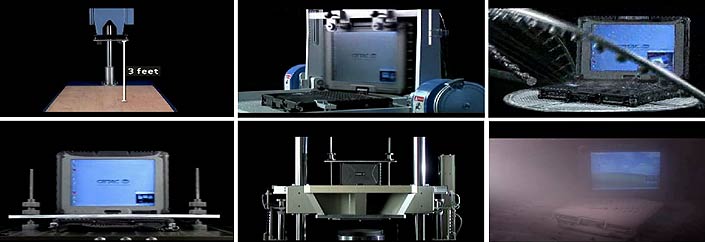
To go into a bit more detail on the individual ruggedness testing categories:
IP ratings refer to Ingress Protection standards for electrical enclosures, with the first number describing the protection level against solids and the second protection against liquids. The B360's IP66 rating indicates total protection against dust, and the laptop is also protected against strong jets of water from all directions. That is far above semi-rugged laptops' IP52 or IP53 ingress protection ratings.
 In terms of temperature resistance, the B360's extremely wide -20 to 145 degrees Fahrenheit operating temperature range was measured in accordance with MIL-STD-810H, 501.5 Procedure II and 502.5 Procedure II. The computer also passed non-condensing humidity testing up to 95% per MIL-STD-810H, 507.5 Procedure II, and can operate in altitudes up to 15,000 feet (and obviously in aircraft with pressurized cabins) per MIL-STD-810H, 500.5 Procedure II. In terms of temperature resistance, the B360's extremely wide -20 to 145 degrees Fahrenheit operating temperature range was measured in accordance with MIL-STD-810H, 501.5 Procedure II and 502.5 Procedure II. The computer also passed non-condensing humidity testing up to 95% per MIL-STD-810H, 507.5 Procedure II, and can operate in altitudes up to 15,000 feet (and obviously in aircraft with pressurized cabins) per MIL-STD-810H, 500.5 Procedure II.
The device is RoHS-compliant. RoHS stands for Restriction of Hazardous Substances and regulates the use of certain hazardous substances in electronic equipment. The RoHS standard is fully implemented in Europe, with lesser restrictions applying in the US.
Shock, vibration, drop and ESD resistance are all tested according to MIL-STD-810H and other relevant regulatory procedures. Not all results are in the promotional literature or owner's manual (which for now only states "vibration & drop resistant"), so inquire with Getac for specifics and also check Getac's MIL-STD-810H compliance testing table (see here).
With respect to the ever important drop spec, Getac's web page specs don't mention a particular drop height, just that the tests performed on Getac units include MIL-STD-810H Method 516.6. — transit drop. That one generally requires 26 drops from four feet. Why four feet? Because when designing the drop tests, the government figured that if you drop something while standing, it'll drop about four feet, as opposed to something that falls off a table or counter, which is 2.5 to three feet. Getac, however, informed us that the B360 has passed the tests from a drop height of six feet. That is impressive.
I should mention that optionally available is ANSI/UL 121201, CSA C22.2 NO. 213 certification as electrical equipment for use in Class I, Division 2 hazardous locations (i.e. places where ignitable concentrations of flammable gases, vapors or liquids may happen). There are multiple configuration options to fit desired usage scenarios in potentially explosive environments typically found in the oil and gas, petrochemical, aviation and related industries.
Finally, Getac's rugged mobile computer decontamination document (see here) recommends a number of commonly available disinfectants for the B360. Those have all been tested for 10,000 swipe-downs at a pressure of 14.22 psi.
LumiBond® 2 display works well indoors and out
Computer displays have come a very long way since the early days of the PC, with many of today's displays being pretty much perfect. Indoors, that is. Outdoors, the sun can overwhelm the brightest display, and there are reflections that can make a screen difficult to see and use. Clearly, outdoor/sunlight viewability is of crucial importance to users of rugged laptops such as the Getac B360.
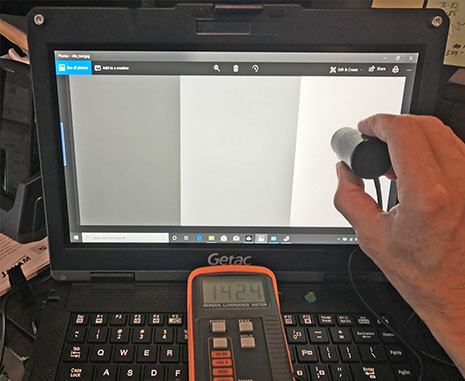 As a result, rugged computer manufacturers have long been in a race for the best possible outdoor/sunlight-viewable display technology. As a result, rugged computer manufacturers have long been in a race for the best possible outdoor/sunlight-viewable display technology.
Several years ago, Getac came up with their "QuadraClear®" (see QuadraClear® page) display technology. The term refers to its four core features: a bright backlight, anti-reflective coatings, linear polarizer, and circular polarizer.
All major manufacturers of outdoor-usable mobile computing equipment use those technologies, and so the difference boils down to a) backlight brightness and b) the extent to which the expensive optical coatings are applied and how the various layers are bonded (the fewer reflective surfaces, the better). Getac calls their layer bonding process "LumiBond®" (see LumiBond® page).
What constitutes a "powerful" backlight? That's where luminance, the intensity of light emitted, comes in.
Luminance is measured in candela per square meter, where candela refers to luminous intensity, the power emitted by a light source. Since "candela per square meter" is a bit cumbersome, the industry uses "nits" which really is just short for "units".
 A standard laptop display is generally in the 200 nits range, and rarely reaches 300 nits. Premium tablets are in the 400-600 nits range. Some heavy-duty rugged gear went as high as 1500 nits, but that generally required a massive, heavy battery. A standard laptop display is generally in the 200 nits range, and rarely reaches 300 nits. Premium tablets are in the 400-600 nits range. Some heavy-duty rugged gear went as high as 1500 nits, but that generally required a massive, heavy battery.
The Getac B360 display is very bright, 1400 nits, while the various optical treatments cut down the percentage of incoming ambient light. That's important because the ratio between the backlight and the reflected incoming ambient light determines the effective contrast ratio, which then translates into the degree of real world outdoor readability of a display.
The matrix below shows the B360 display under a wide variety of viewing conditions.
Overall, its sheer brightness precludes the picture from washing out, the way it does on lesser screens, under almost any lighting condition. The semi-matte surface also totally eliminates the sharp reflections that bedevil standard "glossy" displays outdoors.
There are, however, no completely perfectly solutions to outdoor viewability with current display technology. Getac made this display as bright as possible while, with prudent use of full brightness, still offering generous battery life. But even with a semi-matte displays surface, reflections manifest — not in a distracting mirror-like way, but a degree of milkiness when the display diffuses light.
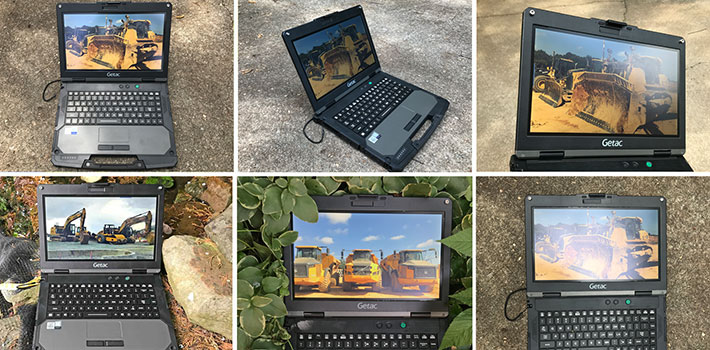
As is, the B360 display is excellent. Both glossy and semi-matte screens have their pros and cons, but outdoors and in the sun, semi-matte's ability to diffuse the sharp reflections of glossy screens can be a distinct advantage. This is about as good as it currently gets.

Glove touch and handling rain
One of the limiting issues with capacitive multi-touch is that in its generic form, it only works with human fingers or, to a lesser extent, with capacitive styli. Capacitive touch doesn't like rain and it won't accept thick gloves and such. Unfortunately, wetness and the need for gloves is exactly what one encounters out there where machines such as the Getac B360 are often used.
Getac was one of the first to address these issues, and solutions have been part of the LumiBond® 2.0 technology for several years. There's a special G-Manager "Touch Screen" display where users can select "Touch," "Glove," or "Pen." Here's how it works:
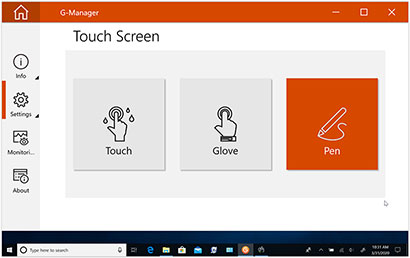 "Touch" is the default mode. Drops near the hand on the "Touch" icon indicate that touch continues to work "with direct exposure to rain." How exactly Getac does that is part of their intellectual property. "Touch" is the default mode. Drops near the hand on the "Touch" icon indicate that touch continues to work "with direct exposure to rain." How exactly Getac does that is part of their intellectual property.
Water is so conductive that it affects the capacitance between two electrodes, which is the concept upon which projected capacitive touch is built. What can be done is switching from a standard mutual capacitance mode to self-capacitance where the capacitance between one electrode and the ground is measured instead of the capacitance between two electrodes. That would preclude a capacitive pen from working in this mode because a fairly large touch area is required. The capacitive pen does work, however, so what Getac did is make sure the light touch of a rain drop is not interpreted as a finger touch.
"Glove" allows the B360 to be operated with gloves. That is done by increasing the sensitivity of the touch controller, so that it can recognize a finger even a brief distance away from the screen, as in the distance that the material of a glove adds to the finger's distance from the screen. That's the way Getac seemed to have done it, as not only do gloves work in this mode, but the cursor now follows the finger even when it is a short distance away from the surface, and touch operations no longer require a firm touch.
"Pen" mode is for use with the dual-mode input option. Touch continues to work in pen mode, but the system will not recognize touch when it sense the pen in use, and vice versa. Pen mode is also for use with narrow-tip capacitive pens, where the smaller contact area of the stylus takes priority over the large contact of finger touch.
Summary: Getac B360 fully rugged notebook computer
With the new B360, Getac offers something its main rival, Panasonic, actually doesn't have: a modern, full-size, fully rugged laptop that isn't bulky and doesn't weigh a ton. In fact, with this thoroughly modern laptop, Getac has done the seemingly impossible: make a machine that can handle whatever hazard or abuse comes its way, yet is no bulkier, and weighs no more, than the competition's semi-ruggeds. That is remarkable.
So to just quickly reiterate, the Getac B360 weighs barely over five pounds, offers superior performance thanks to using state-of-the-art technology (like Intel 10th gen Core chips and PCIe NVMe storage), and sports the kind of full, uncompromising ruggedness needed on so many jobs.
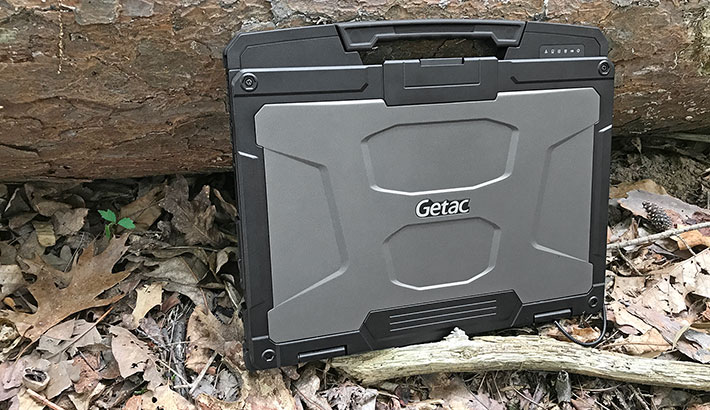
Now add to that a smoothly operating capacitive multi-touch display that's also the brightest available screen in this class (or most others), hot-swappable batteries, things you don't usually get in laptops (like an optional integrated scanner), and also the availability of a B360 "Pro" model for those who need additional features and build options, and you have a platform that is very hard to beat. – Conrad H. Blickenstorfer, July 2020
|
Getac B360 Specifications
|
| Status |
Introduced June 2020, full review July 2020
|
| Type |
Fully rugged notebook
|
| Processor |
Intel Core i7-10710U (1.1 GHz base frequency, 4.7 GHz max turbo)
Intel Core i7-10510U (1.8 GHz base frequency, 4.9 GHz max turbo)
Intel Core i5-10210U (1.6 GHz base frequency, 4.2 GHz max turbo)
|
| Thermal Design Power |
15 watts (all available processors)
|
| Graphics |
Intel UHD Graphics
|
| OS |
Windows 10 Professional (64-bit)
|
| Memory |
8GB DDR4 expandable to 64GB
|
| Storage |
Main storage: 256GB / 512GB / 1TB PCIe NVMe SSD
Optional 2nd storage: 256GB / 512GB / 1TB SATA SSD
|
| Expansion slots |
1 x SD card, 1 x Smart Card
|
| Display type |
IPS TFT LCD, LumiBond® 2.0 sunlight readable LED display
|
| Display size/res |
13.3"/1920 x 1080 pixel (166 ppi) 1400 NITs
|
| Digitizer |
10-point capacitive multi-touch |
| Keyboard |
LED backlit membrane keyboard; optional LED backlit rubber keyboard |
| Housing |
Unknown |
| Size |
13.46" x 11.06" x 1.37" inches (342 x 281 x 35 mm)
|
| Weight |
Starting at 5.1 pounds (2.3 kg); weight as tested with two batteries and stylus: 5.16 lbs.
|
| Operating temperature |
-20° to 145°F (-29° to 63°C) |
| Drop test |
MIL-STD-810H
|
| Ingress protection |
IP66 |
| Vibration |
e-Mark certified for vehicle usage |
| Humidity |
95% RH, non-condensing
|
| Disinfectants |
See Getac rugged mobile computer decontamination
|
| EMI |
MIL-STD-461G certified
|
| Power |
Hot swappable dual 11.1V 2,100 mAH 23.3 whr Li-Ion batteries
|
| Cameras |
Front-facing FHD webcam or optional Windows Hello webcam
|
| Scanning |
Optional barcode scanner
|
| Security |
TPM 2.0, cable lock slot, Smart Card reader, opt. HF RFID reader
|
| Interface |
1 x Headphone out/mic-in combo, DCin Jack, 2 x USB 3.1 Gen2 Type A, 1 x PowerShare USB 2.0, 1 x LAN (RJ45), 1 x HDMI, Docking connector. Configurable I/O Options are serial + VGA OR serial port + USB 3.1 Type C OR serial + DisplayPort
|
| Wireless |
Intel 802.11ax Wi-Fi 6 AX200, Bluetooth v5.1; opt. dedicated GPS OR opt. 4G LTE mobile broadband with integrated GPS, opt. RF antenna pass-through for GPS, WLAN and WWAN
|
| Price |
Inquire |
| Web page |
Getac B360 web page
|
| Brochure |
 Getac B360 brochure/specs Getac B360 brochure/specs
|
| Video |
 Getac B360 promo video Getac B360 promo video
|
| Warranty |
3-year bumper-to-bumper warranty standard |
|
|












